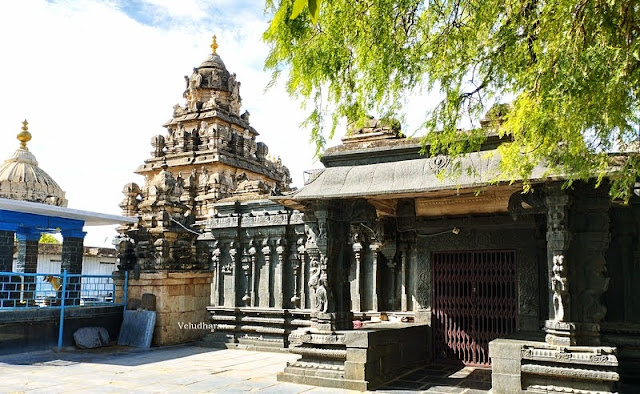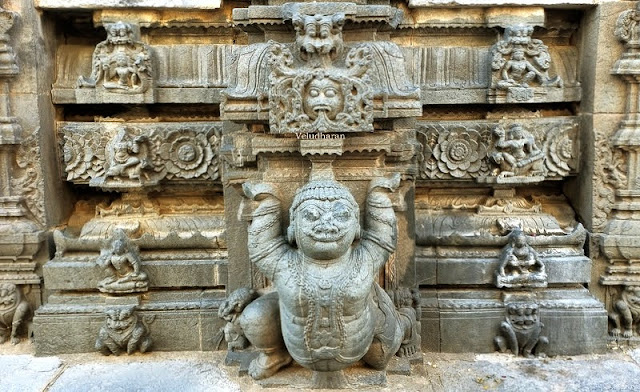The Visit to this Bugga
Ramalingeswara Swamy Temple was a part of the “Shiva and Vishnu Temples/Rock cut
Cave temples of Andhra Pradesh Visit”,
on 24th June 25th June 2023.
Moolavar : Sri Bugga Ramalinga Swami
Consort : Sri Rajarajeswari
Some
of the salient features of this temple are...
The
temple faces west with entrances from West, North, and South. Rajagopuram up
to bases are on the North and South side. Two Rishabas with a Deepa sthambam
are on the south side. A Rishabam, Balipeedam, and Dwajasthambam are on the west
side entrance. Stucco images of Shiva and Parvati are on the top of the west side entrance. Moolavar is of
swayambhu, installed on a natural spring. (Spring – Bugga, Penna River). There
are no images in the koshtam.
Ambal is in a separate temple, and faces west
direction, like Moolavar. Sri Kothanda Ramar Sannidhi is facing South connected with Ambal Temple
Mukha mandapam.
In
the praharam, Padas are (believed to be of Rama) under the Sthala vruksham Vanni
Tree, A Shiva Lingam with Rishabam, Navagrahas, Nagars, Veerabhadra and
Chandikeswara.
ARCHITECTURE
The
North and south side rajagopurams are up to base only. Hindu deities, demons,
ladies, dancers, and musical instrument players, the sculptures related to culture
prevailed during that period and occupied the entire surface of the Rajagopuram
base inside without leaving space.
Moolavar
Temple consists of a sanctum sanctorum, an ardha mandapam, and a maha mandapam. The
sanctum sanctorum is on a kapota bandha adhistanam with silambu kumudam.
Kumbha panjaras are between Kostas. The temple was built with stone from
adhistanam to prastaram. A three-tier stucco vimanam is on the sanctum
sanctorum.
Ambal
temple was constructed similarly to Moolavar temple except for the Vimanam as salakara
Vimanam. Musical pillars are in the Mukha mandapam.
The
temple enclosure is perhaps the finest architectural work executed during
the Vijayanagara Dynasty. The sculpture carved on the lower part and up to the cornices of both North
and south Gopuras, is cut with exquisite sharpness and precision.
HISTORY AND
INSCRIPTIONS
As
per the priest this temple was constructed during Vijayanagara King
Virupaksharaya period, 1460 CE. As per the archaeological Department’s display board, the temple was constructed
during the 16th Century, most probably by Timmanaidu, a local
governor of the Vijayanagara Dynasty.
During the 19th Century, Sir Thomas
Munro, Governor of Madras, period ( 1820 – 1827 CE ) the temple was
reconstructed, which was damaged during The Muslim invasion.
LEGENDS
It
is believed that this Shiva Lingam was installed and worshipped by Rama, hence Shiva
is called Ramalingeswara Swami.
In
another legend, this temple was built where Parasurama, did penance and lived.
In
another Legend Ramalinga, the Chieftain’s cow used to shed its milk at a
particular spot. When the spot was excavated found a Shiva Linga. Ramalinga
Constructed a temple on the same spot.
The Shiva Linga was installed on a natural spring of the River Penna. ( Spring
is locally – in Telugu- called as Bugga
) Hence Shiva is called Bugga Ramalingeswara.
POOJAS AND
CELEBRATIONS
Apart from regular poojas special
poojas are conducted on Maha Shivaratri and Brahmotsavam days.
TEMPLE TIMINGS
The temple will be kept open
between 6.00 hrs -12.00 hrs & 4.00 hrs - 8.00 hrs.
CONTACT DETAILS
The
Mobile number +9194407 32302, may be contacted for further details.
HOW TO REACH
The
temple is on the banks of river Penna, 1.6 km from the Bus stand, about 4 km from
Tadipatri railway station, 112 km from Kadapa, 249 km from Nellore, and 382 km from Chennai.
Nearest
railway Station is Tadipatri.
LOCATION OF THE
TEMPLE: CLICK HERE





























































No comments:
Post a Comment